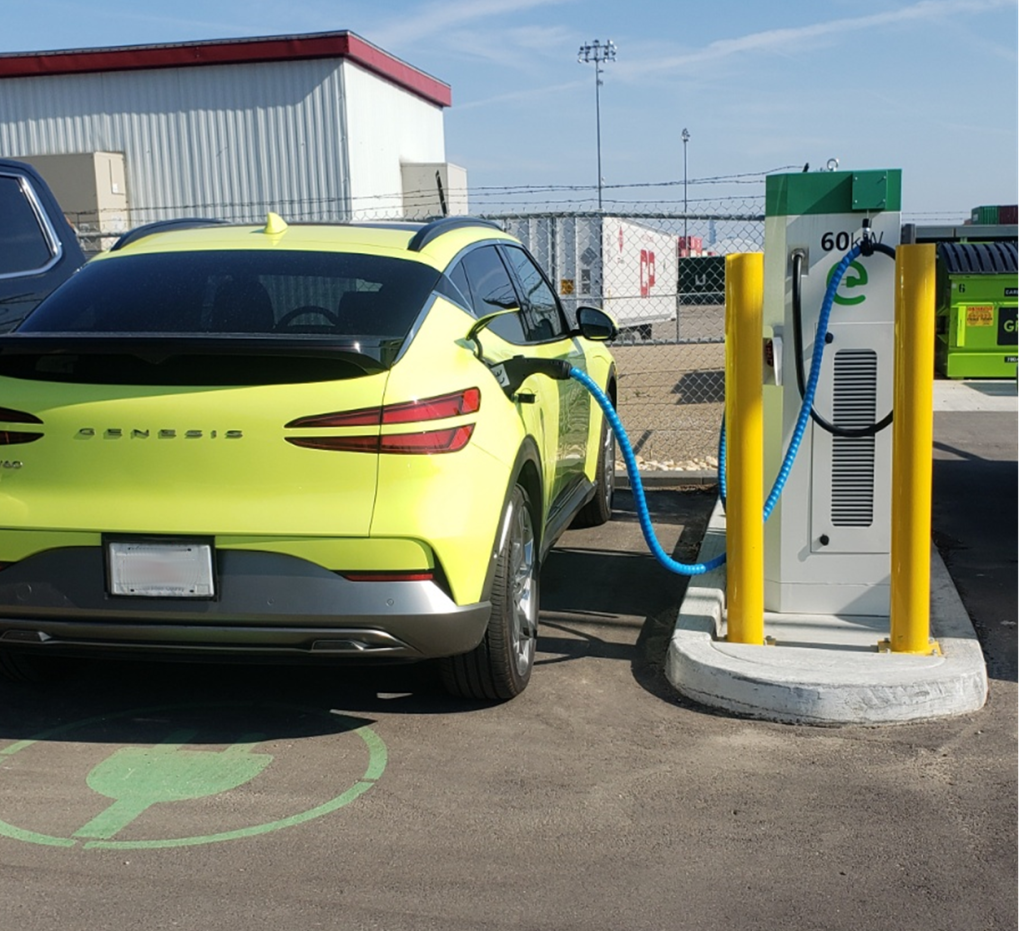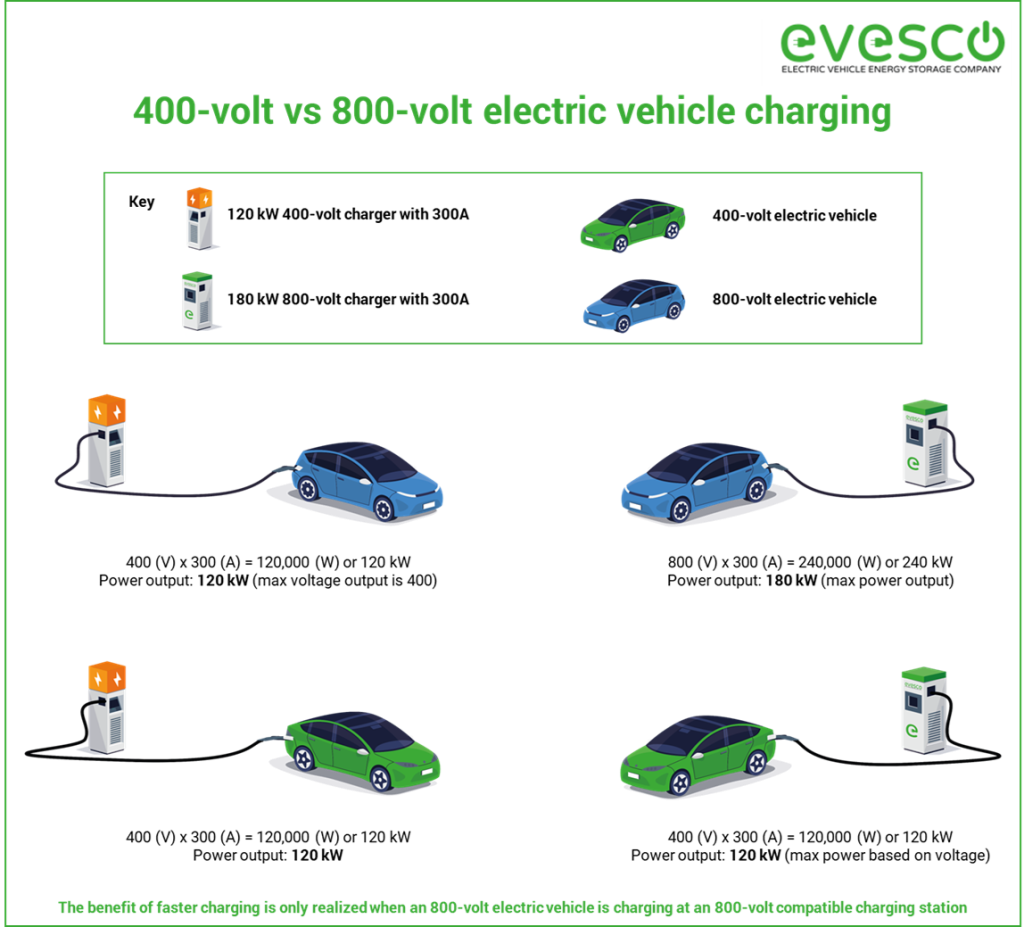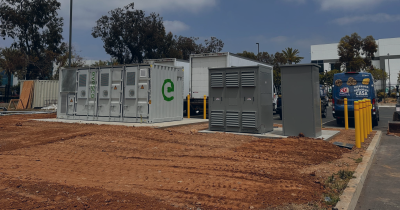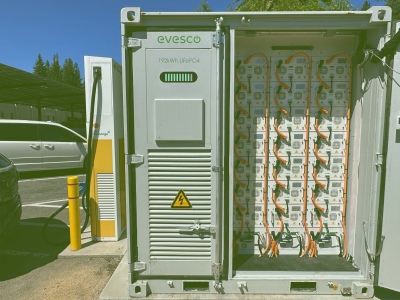400V vs 800V Charging

Electric vehicle (EV) technology is rapidly evolving, revolutionizing sustainable transportation. A vital aspect of this transformation is the advancement of EV batteries, particularly the shift towards higher-voltage battery systems. The emergence of 800V EV architecture promises improved vehicle performance and increased efficiency and speed of EV charging.
This article delves into the differences between 400V and 800V EV architectures and how these systems impact EV charging.
Electric Vehicle Battery Architecture
EV design architecture is complex and comprises various components, including batteries, motors, inverters, sensors, controls, wiring, and auxiliary systems. The specifications and type of components and how they are designed to work together depends on whether the vehicle has a 400-volt or 800-volt battery.
Today, most EVs are built with 400-volt architecture. However, more and more manufacturers are redesigning their vehicles and moving towards 800-volt architecture. This shift is due to the increased efficiency, improved performance, and faster charging capabilities that a higher-voltage battery can offer.
400V vs 800V Architecture
Let’s take a closer look at 400V and 800V architectures.
400V Battery Architecture
Although the term might suggest otherwise, a 400-volt architecture doesn’t have a fixed battery voltage of 400V. Its voltage range is between 300 and 500 volts. The voltage will change depending on the battery’s state of charge (SoC), temperature, age, and operational conditions. Anything within this range is considered 400-volt architecture.
400V systems have long been the standard in EV technology, powering electric vehicles. They cost less than 800V systems thanks to well-established manufacturing and high-volume components, making 400V EVs more affordable for consumers.
EVs with 400V battery systems power their electric motors and work with both 400V and 800V DC fast chargers. However, when connected to an 800V charger, they’re limited to 400V output, which may slow charging depending on the charger’s current.
800V Battery Architecture
In the same way as 400-volt architecture, 800-volt architecture has a voltage range rather than a fixed battery voltage. Its range is between 600 and 900 volts.
Electric vehicles with 800V architecture are available on the market; however, only some manufacturers currently offer them. 800V EVs offer faster charging and longer range than 400V models, giving them a performance edge despite their higher cost from newer technology and developing supply chains. Over time, once more manufacturers move to 800V, prices will decrease and become more affordable.
800V architecture in EVs can enhance efficiency and reduce weight. By increasing the voltage, the current needed is much lower, enabling thinner cables and smaller electronic components. This reduces the vehicle’s weight and minimizes energy losses to heat, thereby increasing overall efficiency and battery range. Higher-voltage batteries can also deliver more power to electric motors, enabling faster acceleration and higher energy capture from regenerative braking.
800V EVs can support faster charging times with chargers capable of delivering the required 800 Vdc output. However, the vehicle requires additional hardware, including a DC/DC converter, as part of its design to adjust the voltage to charge on existing 400V EV chargers. It’s important to note that most installed public DC fast chargers are currently designed for 400V architecture rather than 800V. More on this in a bit.
Differences Between 400V and 800V Architecture
| 400-volt | 800-volt | |
| Charging time | Charge times are limited by the maximum current output capabilities of charging stations. This limitation is due to the heat generated by higher currents ensuring safe and efficient charging. As a result, vehicles with 400-volt EV architecture are unable to fully utilize the capabilities of high-voltage charging stations, leading to charging times that are slower than anticipated. | Supports faster charging from high voltage charging stations, these vehicles can accept greater power due to the lower current they require. This capability allows them to charge more rapidly when using chargers designed for 800V systems. |
| Efficiency / Range | 400-volt architectures typically involve heavier components and experience reduced efficiency due to energy losses from heat generated by higher currents when compared to 800-volt systems. | A decrease in energy loss through heat, coupled with the ability to capture more power via regenerative braking. |
| Weight | Typically require heavier cables, power equipment, and motors due to the higher currents they operate with, leading to an overall heavier design. | The high voltage capabilities of 800-volt architectures allow for the use of lighter cables and components, as they support lower current requirements. |
| Cost | Lower cost to build, benefiting from the use of high-volume components, a well-established and robust manufacturing process, and a strong, existing supply chain. | The production of 800-volt EV architectures tends to be more expensive due to being an emerging technology with a smaller market share, leading to higher costs for components. |
| Charging infrastructure | The majority of public DC fast charging stations are designed for 400-volt electric vehicles. High-powered charging stations can still be utilized but charging speeds will be lower due to the low voltage input. | To fully benefit from the increased charging speeds offered by 800-volt EV architectures, there is a need for more charging stations equipped with higher voltage ranges. Although the majority of existing 400-volt DC fast chargers can be used by 800-volt EVs, this is contingent upon the vehicle being equipped with additional hardware to manage the lower voltage. |
800V EV Cars
Currently the following manufactures offer 800V electric cars:
- Porsche: Taycan
- Kia: EV6, EV9
- Hyundai: IONIQ 5, IONIQ 6
- BYD: ATTO 3, Dolphin, Seal, Song
- XPeng: G9
- GMC: Hummer EV Pickup, Hummer EV SUV
- Genesis: GV60, GV70, G80 (Electric)
- Lucid: Air (uses a 924-volt system)
- Zeekr: 001
- Tesla: Cyber truck
Beyond current 800V EVs, several manufacturers, including Ford (which filed a patent for multi-voltage architecture), Mercedes-Benz, Polestar, Volvo, and Lotus, have committed to adopting 800V systems in future models.

800V Charging
The transition from 400V to 800V battery architecture offers unquestionable benefits. However, challenges still need to be addressed to ensure successful implementation in the market. One of the biggest challenges is charging infrastructure. It is good to have an 800-volt electric vehicle that can charge quicker at higher voltages; however, it is only a benefit if charging at the required high voltage levels is available.
Currently, around 1.5% of DC fast chargers deployed in the US are capable of 800V output; similarly, in the European Union (EU), only approximately 3%. There is a steady increase in the EU; however, in the US, the growth of 800V chargers is stagnant.
The current disparity between 400V and 800V charging stations poses a challenge as EV manufacturers look to release more 800V vehicles. The existing public charging infrastructure was built for 400V EVs and needs to be improved to support 800V EVs effectively. More powerful chargers with higher output voltage ranges are required to utilize the faster charging capabilities fully.
Upgrading or replacing existing charging stations to support 800V charging would be a substantial investment. The higher power delivery demands of 800-volt charging stations could strain the electrical grid when handling the increased load requirements. Expanding infrastructure and deploying 800V-compatible chargers require significant public and private investment, creating challenges in regions with limited resources or early-stage EV adoption.
A multi-pronged approach is needed to address the infrastructural challenges. Governments, utilities, and private companies must collaborate to develop comprehensive infrastructure plans, identify strategic locations, and prioritize high-demand areas for higher-voltage charging station deployment. Offering charging incentives specifically for 800V charging stations can accelerate deployment. A phased rollout of 800V chargers in high-demand areas with strong grid capacity can ease the transition. Innovative options, such as mobile chargers, renewable energy integration, and battery storage, can reduce costly grid upgrades while meeting 800V power demands.
Why is 800-Volt Charging Faster?
The main parameter for measuring the charging speed is the EV charger’s output power, measured in kilowatts (kW). The output charging current and voltage determine the output power. When the charging current is higher, heat generation increases, and so does energy loss. The higher the current, the thicker the cables must be to deliver the needed power. Once the current reaches certain levels, additional liquid cooling is required for the charging station. Increasing voltage and reducing current is a more efficient way to boost charging power. Doubling voltage at the same current can deliver roughly twice the energy to the battery. It is worth noting that the charging station’s output will not exceed the power the EV’s battery can safely accept. This charge acceptance rate of the EV is a critical battery specification designed to ensure safe and efficient charging.
Calculating EV Charging Station Output
Understanding how charger output relates to different EV voltages requires basic electrical knowledge, specifically battery voltage, current, voltage range, and charger power. Here’s a straightforward guide to help estimate the charging station output and its impact on charging time.
The Formula
The power (in watts) provided by the charging station is calculated by multiplying the voltage (in volts) by the current (in amps):
Power (W) = Voltage (V) × Current (A)
Let’s look at a 180kW EV charger from EVESCO as an example for both a 400V EV and an 800V EV.
EV charger specifications: Max Power Output = 180kW, Voltage Range = 300 – 1000V, Max Current = 300A
Charging a 400V EV
Battery Voltage: 400V
Theoretical Power Output: 400 (V) x 300 (A) = 120,000 (W) or 120 kW
Actual Power Output: Since 120kW is less than the station’s max output (180kW), the EV will only receive 120kW.
Charging an 800V EV
Battery Voltage: 800V
Theoretical Power Output: 800 (V) x 300 (A) = 240,000 (W) or 240 kW
Actual Power Output: Since 240kW exceeds the charging station’s max power output, the EV can only receive the maximum charger output, 180kW.

The Impact on Charging Time
Charging time is proportional to the power output. Higher power output leads to faster charging. It’s calculated as:
Charging Time (hours) = Vehicle Battery Capacity (kWh) / Power Output (kW)
The higher the voltage of the vehicle’s battery, the potentially faster the charging, as the power output increases with voltage; this is, of course, only the case for EV chargers, which have an output range covering 800V.
Consider the charger’s maximum power output, as it limits the available power, especially for higher-voltage vehicles.
This simplified guide helps understand how the car battery’s voltage, charger’s amperage, and voltage range influence the charging station’s output and overall charging time. It’s important to note that additional factors like temperature, battery SoC, and the vehicle’s onboard charging limitations can also affect charging performance in real-world conditions.
The shift towards 800V battery architecture in EVs is a significant advancement, promising faster charging times and improved vehicle performance. However, users will only realize these benefits with the appropriate charging infrastructure. There is an urgent need to accelerate the deployment of high-powered charging stations compatible with 800V systems. These stations will cater to current needs and are essential for future-proofing EV infrastructure, playing a crucial role in the transition towards sustainable transportation.



